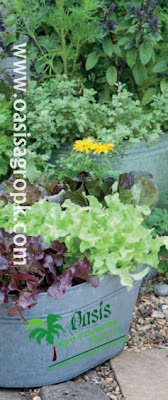Fresh lettuce
|
||
Among the easiest vegetables to grow, lettuces are ideal for pots, where
they can be more easily protected from marauding slugs and snails. The widest
selection is available in seed form, and the cut-and-come-again types are
ready to pick just a few weeks after sowing. Try a mix of lettuces for
different textures and tastes.
|
||
Plants used
Dazzle and
Green
Frills
lettuces
Height and spread
H up to 8in
(20cm)
S up to 12in
(30cm)
Exposure
Sun or
partial shade
Temperature
Fully hardy
Harvesting period
Summer to
winter
Suitable pot size
6in (15cm)
or larger
Container material
Metal,
terra-cotta, plastic, baskets
Compost type
Multi-purpose
compost
TOP TIP: HARVESTING LEAVES
Allow the butter, Romaine, and iceberg varieties to mature into solid
heads of leaves, and then slice the main stem off at the base with a sharp
knife. Cut- and-come-again types can be harvested once by cutting all the leaves
off an inch above the base. New leaves should then regrow, giving you a
second crop.
Alternatively, just pick off a few leaves as and when you need them; more will then grow to replace them.
Growing some of each type gives you
the best of both worlds.
|
Lettuces are not only delicious when picked fresh from the garden,
but they also make decorative features in pots. Fill a container, large or
small, with some multi-purpose compost and sow your seed thinly on the
surface. In small containers, try to sow about three or four seeds of butter,
Romaine, and
iceberg, which form a heart, or just sprinkle cut-and-come-again varieties
more densely; you will not need to thin these out.
Sow a few pots each week for a continuous supply of leaves throughout
the summer, but remember that seeds will not germinate if the temperature is
above 77°F (25°C). When heart-forming varieties reach an inch or so in height, thin them
out to appropriate spacings, which will be given on the packet of seeds, or
leave them a little closer.
|
|
CARING FOR LETTUCES
Keep your lettuces well watered at all times, especially in hot weather
when you will have to water daily, and move pots to a slightly shaded spot in
the height of the summer. Lack of water or too much
heat will cause the plants to “bolt” and produce long flowering stems—the leaves then become bitter.
However, do not allow the compost to become waterlogged or the lettuces will rot.
Most multi-purpose composts contain enough nutrients to sustain lettuces for a
few weeks, but after that, give them a boost with a nitrogen-rich fertilizer
formulated for leafy crops. The main pests to look out for are slugs and
snails. Inspect plants every few days and pick off any culprits.
|
||








0 comments:
Post a Comment